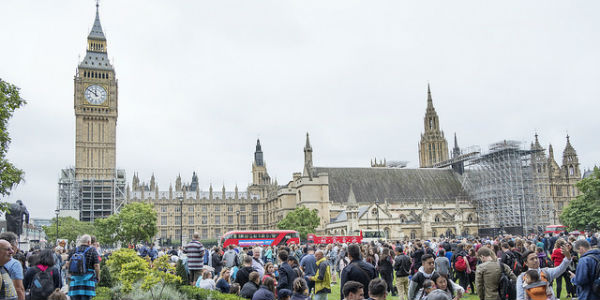Engaging the public with the scrutiny of legislation requires more than just asking for their views
Cristina Leston-Bandeira and Louise Thompson examine the impact of a stage of the legislative process piloted by the House of Commons in 2013, during which the public were invited to comment on a bill undergoing parliamentary scrutiny. They explain why, despite an impressive response, the Public Reading Stage failed to make much of an impact.

Parliament Square. Picture: UK Parliament/Jessica Taylor, via (CC BY-NC 2.0)
Recent years have seen increasing calls for more integration of the public’s views directly into decision-making processes. However, attempts at implementing this in practice are still few and far between. Our recent article in the Journal of Legislative Studies analyses one such attempt: the 2013 Public Reading Stage (PRS) of the Children and Families Bill, an attempt by the House of Commons to integrate the public’s view into the formal legislative process.
The PRS enabled members of the public to submit comments on the specific contents of a government bill, over a period of two weeks, just before it was scrutinised in committee. Over 1000 comments were submitted via a web forum. Our article analyses the impact of the PRS on the actual scrutiny of the legislation. We explore whether the PRS contributed to MPs’ evaluations of the bill, changing it or supporting it in any way. Our study draws on a content analysis of the comments given by the public, complemented by interviews with MPs, officials, and PRS participants.
As the table below illustrates, these comments were often very focused. Over 80% commented on a specific clause, schedule or even word of the bill and almost 50% were based on personal or professional experience. These included some harrowing accounts of the difficulties people were facing in their daily lives and how the legislation might be able to change this. For example, one father told of his own struggle to see his children, stating on the forum that he would support ‘stronger wording’ on shared parenting in the Bill to ensure that 50/50 parenting is assumed from the outset in the family courts.
Mechanisms such as PRS could therefore potentially be a valuable means of incorporating an alternative viewpoint into the scrutiny of a piece of legislation; one that is closer to daily reality, enhancing parliament’s capacity for scrutiny by highlighting what may be a very different point of view and accounts from those who the legislation will directly impact. But we find that although the PRS had an impressive response, it failed to make a tangible impact on the parliamentary scrutiny of the bill. This was largely due to the choice of bill and its poor integration into the formal legislative process.
In some respects the PRS did add value to the bill’s scrutiny. It demonstrated that a wide range of individuals were keen to contribute to discussions about legislation and to suggest improvements. The comments left on the web forum provided an alternative perspective for parliamentarians, offering very personal and emotive accounts of the bill’s potential impact on children and families. The parliamentary scrutiny also chimed well with the most popular issues raised by the public, making the resulting changes conceded by the government have a clear basis of popular support.
But we cannot say that these changes were the direct result of the contributions made at PRS. PRS awareness among parliamentarians was very low and the web forum’s comments were referred to on only a handful of occasions during the bill’s committee stage. So while it may have opened the doors to parliament, providing a new avenue of public participation, it didn’t necessary lead to any changes in the scrutiny of the bill. This may have been due to the choice of a bill which had already received a significant amount of pre-legislative scrutiny.
However, its reduced impact on parliament’s scrutiny of the bill was also the result of a legislative process which was not adapted in any way to formally take account of the PRS. For instance, the positioning of public reading immediately after the bill’s second reading in the Commons severely limited its impact. It gave very little time for the comments to be posted and even less time for their dissemination to those MPs who would be on the bill committee. Rather than adapting the normal legislative process to include the PRS, the PRS was made to fit into it. This is also illustrated by the fact that the summary of the public’s evidence, which was collated by parliamentary officials at the end of the PRS, was submitted to the bill committee as a piece of written evidence. It did not constitute a formal, procedural part of the bill’s scrutiny process. It is no surprise then that the impact on the actual scrutiny of the bill was negligible, despite the richness of the comments submitted by the public.
Our study of the PRS highlights two issues in legislative engagement strategies. The first concerns their purpose. Aiming to enhance scrutiny by integrating genuine experiences from the public does not happen automatically just because the views of the public are collated. The choice of bill used in this case, for instance, clearly had an impact on the PRS’s usefulness. Besides wider issues reflecting the government’s power to influence the choice of bill, the fact this bill had already undergone considerable scrutiny made the PRS in many ways irrelevant, as it added little to the MPs’ understanding of the bill’s consequences. Second, and perhaps most importantly, is the (in)adequacy of established legislative processes to accommodate external inputs.
In this case, the process supporting the PRS could have been more fully integrated into the formal parliamentary scrutiny of the bill. Engaging the public with legislative scrutiny means nothing if parliamentarians themselves do not utilise and consider the public’s input. This may mean better dissemination of the public’s comments to MPs and peers, the positioning of PRS at an earlier stage of the legislative process (perhaps as a form of pre-legislative scrutiny), or a period of time allocated on the floor of the House or in committee specifically for the discussion of the public’s view.
The analysis of the UK Parliament’s attempt to integrate the public’s voice into the legislative process shows, therefore, that while the public’s view may enhance the understanding of the consequences of a bill and therefore enhance its scrutiny, this in itself does not constitute effectiveness. In order to have a greater impact on legislation, its integration needs to be thought through as something more integral to the legislative process rather than simply sitting in parallel with it. Integrating the public’s view directly into representative institutions requires a very careful consideration of their role and of the processes in place to facilitate it and to maximise its effect on scrutiny.
The article gives the views of the author and not Democratic Audit. It was originally published on the LSE British Politics and Policy blog.
Note: the above draws on the authors’ article “Integrating the view of the public into the formal legislative process: public reading stage in the House of Commons” published in the Journal of Legislative Studies. If you don’t have access and would like a copy, please contact the authors directly.
 Cristina Leston-Bandeira is Professor of Politics at the University of Leeds. She tweets @estrangeirada.
Cristina Leston-Bandeira is Professor of Politics at the University of Leeds. She tweets @estrangeirada.
 Louise Thompson is Lecturer in British Politics at the University of Surrey. She tweets @louisevthompson.
Louise Thompson is Lecturer in British Politics at the University of Surrey. She tweets @louisevthompson.






 Democratic Audit's core funding is provided by the Joseph Rowntree Charitable Trust. Additional funding is provided by the London School of Economics.
Democratic Audit's core funding is provided by the Joseph Rowntree Charitable Trust. Additional funding is provided by the London School of Economics.